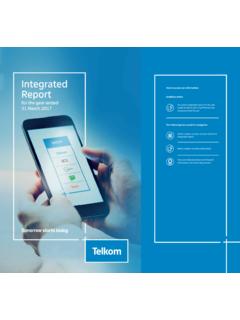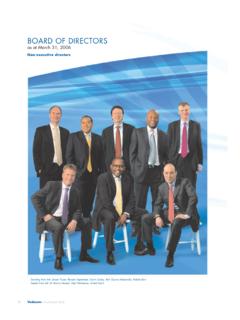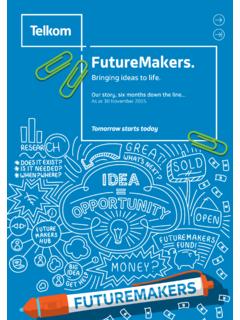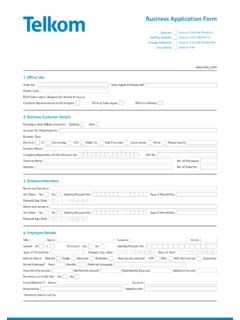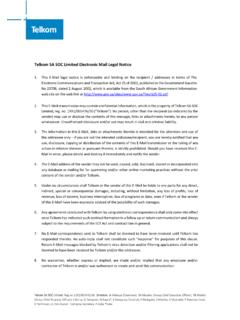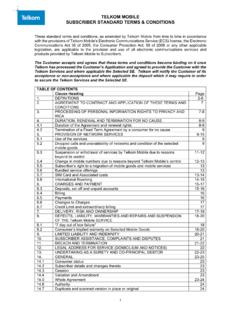Transcription of Unified Communications - telkom.co.za
1 Paveshen GovenderSenior Manager Unified CommunicationsTel : +27 12 680 8319 Cell : +27 81 362 3111 Email : CommunicationsTomorrow starts todayIntroduction to Unified communicationsPreparing telecommunications,network and hosting servicesprovidersTelkom Business s hostingand cloud servicesApplication of Unified communicationsUnified communicationsImplementation strategiesUnified communicationskey benefitsUnified communicationscase studiesEnabling Unified communicationsvalueConclusion01 telkom | 2015 Unified Communications in Today s WorldUnified Communications (UC) is playing an increasingly valued role in enterprise Communications as it serves to transform disparate (silo) communication systems into a common interface that makes it quicker and easier to Unified Communications is designed to support a single Communications platform, it breaks down geographical, communication mode, device, and user-accessibility barriers, thus enabling people to be reached easily anywhere, there is a common understanding of the increasing role that Unified Communications is playing across enterprises in various sectors, the solution can also present challenges if not implemented properly.
2 Therefore it is essential that proper guidance is sought and followed in order for enterprises to realise maximum benefits from what the Unified Communications solution has to offer. In this article, the objectives are to provide enterprises with a thorough understanding of Unified Communications developments as well as its benefits. The article will also provide essential guidance on how to implement the solution and highlight the key strengths of telkom Business as the right partner to help customers extract the most value for moving to a Unified Communications to Unified communictions02 telkom | 2015 Defining Unified CommunicationsOne of the most commonly used and accepted definitions of Unified Communications is the integration of real-time communication services such as Instant Messaging (IM), presence, Internet Protocol Telephony (IP telephony), video and data sharing with non-real-time communication services such as Unified messaging (UM) and voice mail.
3 IP telephony encompasses technologies that use IP networks to transmit voice and other forms of information as packets of data as opposed to being traditionally carried over circuit-switched connections such as Public Switched Telephone Network (PSTN) and public data includes UM and IM the former refers to the integration of non-real-time applications such as email, SMS, voicemail, and fax messages, while the latter refers to the use of real-time applications such as online chats that are transmitted as text. Presence information allows others to see in real-time the status of someone s availability on the network and to select an appropriate method to communicate with , Unified Communications includes collaboration tools such as conferencing (audio, video and web conferencing). Web collaboration provides the tools an organisation requires to increase sales, facilitate new revenue-generating opportunities, and to enhance customer satisfaction and loyalty.
4 Collaboration capabilities include shared workspaces, file and document sharing for employees to manage and share efficiently without having to leave the Unified Communications 03 telkom | 2015 The following figure gives a detailed view of the components of Unified Communications and 1: Unified Communications and Collaboration ComponentsAs presented in figure 1, Unified Communications comprises of various components. Essentially that means the solution does not refer to one product or service offering. Instead, it is a combination of two or more real-time and non-real-time communication service components or categories that provide constant access to the enterprise s resources for employees and customers or stakeholders to access virtually anywhere. Similarly, the Unified Communications market comprises of various players. Major vendors include Cisco, Microsoft, Avaya and Unify. The vendors are typically dominant in specific areas within the broader Unified Communications service categories with large enterprises essentially requiring the best-of-breed Unified Communications functionalities across the vendors.
5 Inherently, large enterprises require working with a service provider that can integrate vendor offerings into a seamless solution. PresenceMobilityVideoTelephonyContentCen treUnifiedMessagingConferencingUnified Communications & Collaboration (UCC)Social Media integrationSource: telkom Business, 201404 telkom | 2015 03 Unified Communications Industry TrendsThe Unified Communications market is growing steadily thanks to enterprise mobility demands, innovative technologies and a robust vendor landscape. By contrast, the global telephony market shows the traditional PBX market is in decline. Unified Communications services (and cloud-based IP-PBX services) are seen to be primarily responsible for the decline in the PBX market. The accelerating adoption of Unified Communications application services has led to a reported 31% year-on-year growth in 2013 1 or 16% compounded annual growth rate (CAGR) from 2012 to 2018 2 worldwide.
6 Revenues were estimated at billion in 2011 and predicted to reach billion in 2018 globally. In South Africa, 91% of large enterprises had strategic plans by 2013 to evaluate and implement two or more components of Unified Communications applications in the medium term against 78% two years before factors are influencing the trends characterising the market today. The most commonly identified trends within the Unified Communications space are: The move from on premise (capex intensive) to hosted (opex-based) deployment models necessitated by the enterprises need to reduce upfront deployment costs, focus on core business competencies and respond quickly to the rapidly evolving Communications landscape. The move to cloud-based Unified Communications in order to speed up deployment, and meet scalability and availability requirements. Scalability is essentially critical for addressing an enterprise s immediate demands due to growth while availability is critical where an enterprise s operations become more dispersed and centralised models are unable to meet the distributed Communications trends and drivers 1 Infonetics Research, Enterprise Unified Communications and Voice Equipment, 2014 2 Transparency Market Research, Unified Communications Market 2012 2018, 2013 3 Ovum, The Future of Unified Communications & Collaboration, 201305 telkom | 2015 Selective deployment of Unified Communications components indicating that the solution s journey is different across enterprises.
7 This is because not all Unified Communications components are deployed at the onset. Most enterprises initially deploy some components of Unified Communications in particular IP telephony, IM, and presence. Further application components such as video conferencing are added later. The applications may come from different vendors depending on what presents the best business case to the enterprise. Consolidation of voice, data and video on to a single (all-IP) network to make for an effective management of all Communications networks if they are on a single platform. Enterprises recognising the growing importance of Bring Your Own Device (BYOD) as employees increasingly use their personal devices such as mobile phones and tablets to perform their work-related functions. That means enterprises that accept the BYOD trend can benefit if personal devices are used to improve employee productivity. Increasing interest in WebRTC as a result of users being able to click-to-call from a web page or mobile app without having to go through the traditional route of picking up the phone to make a call.
8 Video Collaboration evolving the way enterprises interact with their customers. Overall customer experience is transformed by an organisation s ability to link a customer to an expert first time through video interactions. Early Unified Communications adoption rate by enterprises in certain vertical circles such as financial services, healthcare, education and retail. Many have deployed on premise Unified Communications but are moving to hybrid models to take advantage of the increased availability and scalability the hosted or cloud-deployment models the trends presented may paint a global picture, similar trends are prevailing in South Africa. For instance, enterprises are adopting an outsourcing approach as they look to strategic partnerships to manage their day-to-day Communications requirements which constantly require updating to meet the expanding or changing needs of the business. 06 telkom | 2015 Unified Communications Business DriversThe changes in Communications and application technologies and end-user trends such as mobility and BYOD are influencing the value and therefore the business drivers, compelling the adoption of Unified Communications .
9 Unified Communications business drivers, however, need to be understood not as an ICT product but rather as a tool to better leverage internal resources and improve the effectiveness and efficiency of Communications with customers and business partners. Figure 2: UC Impact on Business Drivers The key business drivers for Unified Communications typically consist of a combination of internally focused business productivity, employee collaboration and cost avoidance together with externally focused customer sales and service needs. There are, fundamentally, three ways Unified Communications solutions impact on an enterprise s business drivers: tangible, intangible and technology business drivers. Source: telkom Business, 2014Do enterprises make strategic UC investments based on quantifiable cost savings thatthey will realise from committing to such investments? Tangible Business DriversIntangible Business DriversTechnology Business DriversDoes the enterprise need to evaluate the business case for Unified Communications based on productivity and perceived customer acquisition and loyalty attributes?
10 Does Unified Communications complement or augment the existing ICT strategy and key projects( cloud, big data, virtualisation, convergence, vendor consolidation etc.) in order to meet both tangible and intangible business drivers?07 telkom | 20151. To eliminate redundant infrastructure2. To reduce travel expenses3. To reduce IT staff overheads4. To reduce communication costsTangible Business DriversA growing demand for access to video communicationand collaborationEasy management of complexity of communicating across multiple channels, devices and user preferencesIncreasing integration & interoperability of voice, video & collaboration tools with business applicationsStandardised and reduced silos across Communications , telephony & collaboration systems Converging of Communications technologies across fixed & mobile voice & data services and across ICT infrastructure & applications Tangible business drivers typically involve quantifiable savings in terms of monetary gains.
